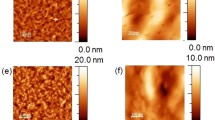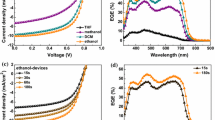Abstract
Squaraine (SQ) dyes have been considered as efficient photoactive materials for organic solar cells. In this work, we purposely controlled the molecular aggregation of an SQ dye, 2,4-bis[4-(N,N-dibutylamino)-2-dihydroxyphenyl] SQ (DBSQ-(OH)2) in the DBSQ(OH)2:[6,6]-phenyl-C61-butyric acid methyl ester (PCBM) blend film by using the thermal annealing method, to study the influence of the molecular aggregation on film properties as well as the photovoltaic performance of DBSQ(OH)2:PCBM-based bulk heterojunction (BHJ) solar cells. Our results demonstrate that thermal annealing may change the aggregation behavior of DBSQ(OH)2 in the DBSQ(OH)2:PCBM film, and thus significantly influence the surface morphology, optical and electrical properties of the blend film, as well as the photovoltaic performance of DBSQ(OH)2:PCBM BHJ cells.
Similar content being viewed by others
References
Günes S, Neugebauer H, Sariciftci N S. Conjugated polymerbased organic solar cells. Chemical Reviews, 2007, 107(4): 1324–1338
Li Y. Molecular design of photovoltaic materials for polymer solar cells: toward suitable electronic energy levels and broad absorption. Accounts of Chemical Research, 2012, 45(5): 723–733
Li G, Zhu R, Yang Y. Polymer solar cells. Nature Photonics, 2012, 6(3): 153–161
Jiang W, Yu R, Liu Z, et al. Ternary nonfullerene polymer solar cells with 12.16% efficiency by introducing one acceptor with cascading energy level and complementary absorption. Advanced Materials, 2018, 30(1): 1703005
Yu G, Gao J, Hummelen J C, et al. Polymer photovoltaic cells: Enhanced efficiencies via a network of internal donor–acceptor heterojunctions. Science, 1995, 270(5243): 1789–1791
Roncali J, Leriche P, Blanchard P. Molecular materials for organic photovoltaics: small is beautiful. Advanced Materials, 2014, 26 (23): 3821–3838
Chen G, Wang T, Li C, et al. Enhanced photovoltaic performance in inverted polymer solar cells using Li ion doped ZnO cathode buffer layer. Organic Electronics, 2016, 36: 50–56
Cheng P, Zhang M, Lau T K, et al. Realizing small energy loss of 0.55 eV, high open-circuit voltage>1 V and high efficiency> 10% in fullerene-free polymer solar cells via energy driver. Advanced Materials, 2017, 29(11): 1605216
He Z, Xiao B, Liu F, et al. Single-junction polymer solar cells with high efficiency and photovoltage. Nature Photonics, 2015, 9(3): 174–179
Huang J, Li C Z, Chueh C C, et al. 10.4% Power conversion efficiency of ITO-free organic photovoltaics through enhanced light trapping configuration. Advanced Energy Materials, 2015, 5 (15): 1500406
Duan S N, Dall’Agnese C, Ojima H, et al. Effect of solventinduced phase separation on performance of carboxylicindolinebased small-molecule organic solar cells. Dyes and Pigments, 2018, 151: 110–115
Huang Y, Kramer E J, Heeger A J, et al. Bulk heterojunction solar cells: morphology and performance relationships. Chemical Reviews, 2014, 114(14): 7006–7043
Wang T, Chen C, Guo K, et al. Improved performance of polymer solar cells by using inorganic, organic and doped cathode buffer layers. Chinese Physics B, 2016, 25(3): 038402
Wei G, Wang S, Renshaw K, et al. Solution-processed squaraine bulk heterojunction photovoltaic cells. ACS Nano, 2010, 4(4): 1927–1934
Mayerhöffer U, Deing K, Gruss K, et al. Outstanding short-circuit currents in BHJ solar cells based on NIR-absorbing acceptorsubstituted squaraines. Angewandte Chemie International Edition, 2009, 48(46): 8776–8779
Sasabe H, Igrashi T, Sasaki Y, et al. Soluble squaraine derivatives for 4.9% efficient organic photovoltaic cells. RSC Advances, 2014, 4(81): 42804–42807
Chen G, Sasabe H, Wang Z, et al. Co-evaporated bulk heterojunction solar cells with>6.0% efficiency. Advanced Materials, 2012, 24(20): 2768–2773
Chen G, Sasabe H, Igarashi T, et al. Squaraine dyes for organic photovoltaic cells. Journal of Materials Chemistry A: Materials for Energy and Sustainability, 2015, 3(28): 14517–14534
Chen G, Sasabe H, Sasaki Y, et al. A series of squaraine dyes: effects of side chain and the number of hydroxyl groups on material properties and photovoltaic performance. Chemistry of Materials, 2014, 26(3): 1356–1364
Chen G, Sasabe H, Wang Z, et al. Solution-processed organic photovoltaic cells based on a squaraine dye. Physical Chemistry Chemical Physics, 2012, 14(42): 14661–14666
Chen G, Si C, Zhang P, et al. Efficiency enhancement in DIBSQ: PC71BM organic photovoltaic cells by using Liq-doped Bphen as a cathode buffer layer. Frontiers of Materials Science, 2017, 11(3): 233–240
Wu J, Si C, Chen Y, et al. Photovoltaic devices prepared through a trihydroxy substitution strategy on an unsymmetrical squaraine dye. Chemistry, 2018, 24(13): 3234–3240
Würthner F, Kaiser T E, Saha-Möller C R. J-aggregates: from serendipitous discovery to supramolecular engineering of functional dye materials. Angewandte Chemie International Edition, 2011, 50(15): 3376–3410
Deing K C, Mayerhöffer U, Würthner F, et al. Aggregationdependent photovoltaic properties of squaraine/PC61BM bulk heterojunctions. Physical Chemistry Chemical Physics, 2012, 14 (23): 8328–8334
Spencer S, Hu H, Li Q, et al. Controlling J-aggregate formation for increased short-circuit current and power conversion efficiency with a squaraine donor. Progress in Photovoltaics: Research and Applications, 2014, 22(4): 488–493
Brück S, Krause C, Turrisi R, et al. Structure–property relationship of anilino-squaraines in organic solar cells. Physical Chemistry Chemical Physics, 2014, 16(3): 1067–1077
Zheng C, Penmetcha A R, Cona B, et al. Contribution of aggregate states and energetic disorder to a squaraine system targeted for organic photovoltaic devices. Langmuir, 2015, 31(28): 7717–7726
Chen G, Sasabe H, Lu W, et al. J-aggregation of a squaraine dye and its application in organic photovoltaic cells. Journal of Materials Chemistry C: Materials for Optical and Electronic Devices, 2013, 1(40): 6547–6552
Chen G, Si C, Zhang P, et al. The effect of processing solvent dependent film aggregation on the photovoltaic performance of squaraine:PC71BM bulk heterojunction solar cells. Organic Electronics, 2017, 51: 62–69
Ambade R B, Ambade S B, Mane R S, et al. Interfacial engineering importance of bilayered ZnO cathode buffer on the photovoltaic performance of inverted organic solar cells. ACS Applied Materials & Interfaces, 2015, 7(15): 7951–7960
Mishra A, Bäuerle P. Small molecule organic semiconductors on the move: promises for future solar energy technology. Angewandte Chemie International Edition, 2012, 51(9): 2020–2067
Beverina L, Drees M, Facchetti A, et al. Bulk heterojunction solar cells – tuning of the HOMO and LUMO energy levels of pyrrolic squaraine dyes. European Journal of Organic Chemistry, 2011, 2011(28): 5555–5563
Acknowledgments
This work was financially supported by the National Natural Science Foundation of China (Grant No. 61604093), the Shanghai Pujiang Program (16PJ1403300), the Natural Science Foundation of Shanghai (16ZR1411000), the Science and Technology Commission of Shanghai Municipality Program (17DZ2281700), and the Shanghai Software and integrated circuit industry development special funds (170401).
Author information
Authors and Affiliations
Corresponding author
Electronic supplementary material
Rights and permissions
About this article
Cite this article
Zhang, P., Ling, Z., Chen, G. et al. Influence of thermal annealing-induced molecular aggregation on film properties and photovoltaic performance of bulk heterojunction solar cells based on a squaraine dye. Front. Mater. Sci. 12, 139–146 (2018). https://doi.org/10.1007/s11706-018-0417-0
Received:
Accepted:
Published:
Issue Date:
DOI: https://doi.org/10.1007/s11706-018-0417-0




